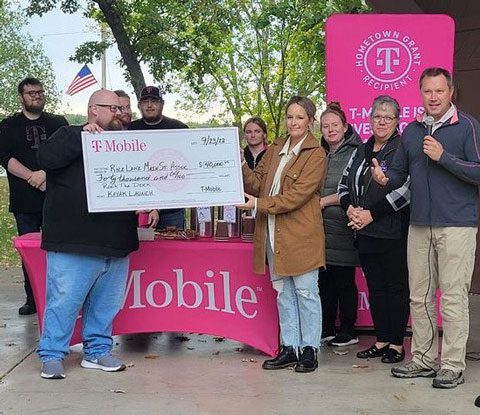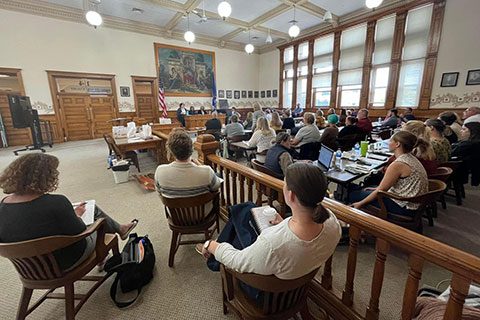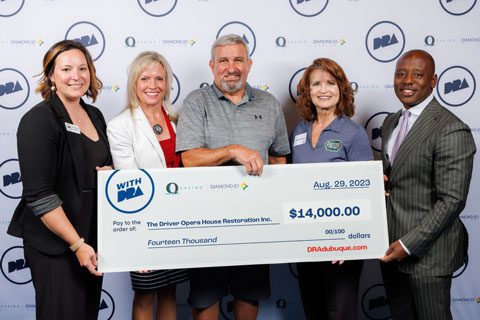
The Rice Lake Main Street Association received $40,000 from T Mobile to add an accessible kayak launch adjacent to downtown, activating the lakefront.
The strong turnout for September’s downtown development workshop on grant writing demonstrates that fundraising is a critical topic for every community and organization and grants are an important tool to achieve funding goals.
More than two-thirds of downtown organizations in the state received some grant funding in fiscal year 2023. Grant funding allows organizations to accomplish more, more quickly. However, writing grants can be intimidating and time consuming, and there’s no guarantee the request will be approved. This article highlights best practices and strategies organizations can employ to maximize their chance for success when they apply for a grant.
Preparation
The first step in grant writing is to have a good grasp of your organization’s mission, vision, and strategic plan. Being able to clearly convey what projects you are working on, how these projects meet a need in your community, whom they will benefit, and how much they will cost is essential for an application to receive serious consideration. With few exceptions, grant providers are looking to fund projects that are ready to go and can demonstrate that they have the capacity and resources to complete the proposed project or activity.

More than 50 people from around the state participated in our grant writing workshop in September to build capacity for local initiatives.
Elements of a successful grant include:
- Identify the Challenge: Provide data and stories that illustrate the need for the project.
- Set Goals: Use the SMART framework; Specific, Measurable, Actionable, Relevant and Time-bound. What do you hope to achieve, by when, how, and for whom? What is the benefit if you are successful and the cost of doing nothing? Why is this important now?
- Methods: What specifically do you plan to do, who will do it, and how will you measure the project’s success? Include background information on those who will lead the project.
- Evaluation: Demonstrate that you understand the challenge and that you have not only the capacity to carry out your project but also to measure its success. Include testimonials or case studies from previous related projects, survey data, or other useful information that is specific to your community or organization.
- Budget: What are the costs associated with the project? What other sources of funding will support the project, including in-kind contributions and volunteer or staff time?
Since most grants have relatively short windows of opportunity from the time they are announced to the deadline for applications, having this information pulled together or easily accessible makes it much faster to submit a quality application. Also, many grant managers are willing to review draft applications and suggest improvements if the paperwork is ready well in advance.
Matchmaking

Darlington’s Driver Opera House restoration benefitted from numerous grants, including $14,000 from the Dubuque Racing Association as part of their multi-year campaign
Once you have a clearly defined project, budget, and partners, look for organizations offering grants that are a good fit for your project. Possibilities include:
- Community-based foundations, utility providers, and civic groups: These groups accept applications for a wide range of activities that broadly benefit the local community. They often have the least complex application requirements, but they also tend to have the smallest pool of grant dollars. Local foundations may administer multiple charitable funds that can be combined, so a conversation with the local program manager is the best place to start.
- Corporate foundations or other types of corporate giving: Corporate giving generally follows one of two paths—in communities in which they operate, corporations may support projects related to their industry or projects to which their employees are committed. For large corporations, support may be available for broader geographies but limited to a mission related to their industry. For example, grocery chains may get involved in efforts to fight hunger, while toy manufacturers may support campaigns aimed at helping children. Projects that can benefit from in-kind contributions (such as equipment or materials) are particularly suited for this type of funding partner.
- Private foundations: Grants from private donors come in all sizes; these foundations tend to be values-based and focus on projects that align with their goals. They may be more likely to become long-term partners and may be open to funding general operating expenses if the mission alignment is clear.
- State agencies: Virtually every state agency offers funding specific to its mission. Grants tend to be more substantial, but funding is typically limited to individual projects. State grants also require more thorough application materials and more diligent reporting than private organizations.
- Federal grants: Federal agencies cover a wide range of grant topics and generally offer the highest dollar amounts. However, they also have some of the most stringent application and reporting requirements.
Generally, starting small and local helps build funding for your project and provides a stepping stone that can be useful in seeking larger grants in the future. If no local entities come to mind, ask your local library if it subscribes to the foundation directory, which lets you search by keyword and geography for grantors that might be a good match. When reviewing a potential funding partner, be sure to confirm that its requirements for the type of applicant, geography served, project type, and grant size are all a good fit. Applications that do not meet these criteria often will not be considered. Websites, form 990 filings (from nonprofit organizations), and past press releases are ways to verify this information.
Collaboration

The City of West Allis, working with their BID and a downtown property owner, received $28,000 through the Vibrant Spaces grant program to create a new outdoor event space.
The facilitator for our workshop, Greg Grohman, is a staff grant writer serving a collaboration among the City of Waupaca, the Waupaca School District, and the Waupaca Area Chamber of Commerce. By working together to employ a grant writer, all three entities have access to a dedicated professional who can help them achieve their funding goals. The grant writer can also create stronger applications with matching funds and in-kind assistance for community-wide initiatives involving all three partners. While this type of arrangement is relatively rare in the state, organizations can achieve similar benefits from hosting an annual, community-wide planning session to discuss future projects or needs and identify opportunities for collaborations. Knowing which organizations are working on similar issues makes it easy to secure letters of support or list project partners when needed. These partnerships may also make it easier to complete the required reporting or streamline financial transactions. There may be situations where one organization is eligible to apply for a grant or has the capacity to manage financial reporting while other partners carry out the project’s functions.
The Application

Green Bay’s On Broadway Inc. received $20,000 through the Department of Tourism’s Joint Effort Marketing Grant to fund advertising for their new Christkindl Market event.
Writing and submitting the actual grant application is the smallest piece of the overall process. If the relevant information about your organization, its mission, and its projects and goals is readily available, you can easily write a compelling grant application. It is important to adjust the language to match that of the funding organization. For instance, a project to build a trail alongside a river will have multiple benefits. Depending on the funding source, the application might highlight improved river health, a safe path for children, or an opportunity to improve the health of residents. Focus on those benefits that are relevant to the funding organization. It is also critical to incorporate information that aligns with any evaluation criteria that are spelled out in the grant requirements. Many grants are reviewed by panels that award points based on specific criteria; if an application omits any of these key areas, that will affect the score it receives. Best practices entail specifying how the application meets criteria from the grant requirements to make it as clear as possible for the reviewers.
Before submitting a grant application, make sure that your narrative has been edited, that your budget balances, and that numbers and references are consistent throughout. While many partners might have helped write the application, the final version should have one voice and should be easy for the grant committee to understand. Finally, keep in mind that even well-written applications won’t always be successful. Only about 30% of applications receive funding, Grohman says. The more competitive the grant pool, the less likely an application will receive funding. If an application does not succeed, use this as a learning opportunity; ask the grant program manager for feedback on your application and a list of the grants awarded. You can use this information to better tailor future funding requests and, hopefully, to improve your success rate along the way.
